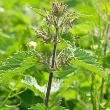Background
- The genus name Urtica comes from the Latin verb urere meaning, "to burn," because of its urticate (stinging) hairs that cover the stem and underside of the leaves. The species name dioica means "two houses" because the plant usually has male or female flowers.
- The most common uses for stinging nettle are treatment of benign prostatic hyperplasia (BPH, enlarged prostate), arthritis, allergies and pain, cough, tuberculosis, as an astringent and expectorant, urinary tract disorders, and externally as a hair and scalp remedy for oily hair and dandruff. It is also frequently used as a diuretic to increase the flow of urine. There are some data supporting the use of nettle in the treatment of symptoms of BPH, but solid clinical data are lacking for other indications.
- Nettle is generally regarded as safe because the plant is also used as a green, leafy vegetable. Other than urticaria ("hives") from contacting the stinging hairs, gastrointestinal discomfort is the only reported adverse effect.
References
Natural Standard developed the above evidence-based information based on a thorough systematic review of the available scientific articles. For comprehensive information about alternative and complementary therapies on the professional level, go to . Selected references are listed below.
- Dantas SM. Menopausal symptoms and alternative medicine. Prim Care Update Ob/Gyns 1999;6:212-220.
- Dathe G, Schmid H. [Phytotherapy of the benign prostatic hyperplasia (BPH). Double-blind study with an extract of Radicus Urticae (ERU)]. Urologe B 1987;27:223-226.
- Hill N, Stam C, van Haselen RA. The efficacy of Prrrikweg gel in the treatment of insect bites: a double-blind, placebo-controlled clinical trial. Pharm World Sci 1996;18(1):35-41.
View Abstract - Koch E. Extracts from Fruits of Saw Palmetto (Sabal serrulata) and Roots of Stinging Nettle (Urtica dioica): Viable Alternatives in the Medical Treatment of Benign Prostatic Hyperplasia and Associated Lower Urinary Tracts Symptoms. Planta Med 2001;67(6):489-500.
View Abstract - Konrad L, Muller HH, Lenz C, et al. Antiproliferative effect on human prostate cancer cells by a stinging nettle root (Urtica dioica) extract. Planta Med 2000;66(1):44-47.
View Abstract - Krzeski T, Kazon M, Borkowski A, et al. Combined extracts of Urtica dioica and Pygeum africanum in the treatment of benign prostatic hyperplasia: double-blind comparison of two doses. Clin Ther 1993;15(6):1011-1020.
View Abstract - Lopatkin N, Sivkov A, Walther C, et al. Long-term efficacy and safety of a combination of sabal and urtica extract for lower urinary tract symptoms--a placebo-controlled, double-blind, multicenter trial. World J Urol 2005;23(2):139-146.
View Abstract - Mittman P. Randomized, double-blind study of freeze-dried Urtica dioica in the treatment of allergic rhinitis. Planta Med 1990;56(1):44-47.
View Abstract - Randall C, Randall H, Dobbs F, et al. Randomized controlled trial of nettle sting for treatment of base-of-thumb pain. J R Soc Med 2000;93(6):305-309.
View Abstract - Schneider T, Rubben H. [Stinging nettle root extract (Bazoton-uno) in long term treatment of benign prostatic syndrome (BPS). Results of a randomized, double-blind, placebo controlled multicenter study after 12 months]. Urologe A 2004;43(3):302-306.
View Abstract - Sokeland J, Albrecht J. [Combination of Sabal and Urtica extract vs. finasteride in benign prostatic hyperplasia (Aiken stages I to II). Comparison of therapeutic effectiveness in a one year double-blind study]. Urologe [A] 1997;36(4):327-333.
View Abstract - Sokeland J. Combined sabal and urtica extract compared with finasteride in men with benign prostatic hyperplasia: analysis of prostate volume and therapeutic outcome. BJU Int 2000;86(4):439-442.
View Abstract - Tahri A, Yamani S, Legssyer A, et al. Acute diuretic, natriuretic and hypotensive effects of a continuous perfusion of aqueous extract of Urtica dioica in the rat. J Ethnopharmacol 2000;73(1-2):95-100.
View Abstract - Taskila K, Saarinen JV, Harvima IT, et al. Histamine and LTC4 in stinging nettle-induced urticaria. Allergy 2000;55(7):680-681.
View Abstract - Vontobel HP, Herzog R, Rutishauser G, et al. [Results of a double-blind study on the effectiveness of ERU (extractum radicis Urticae) capsules in conservative treatment of benign prostatic hyperplasia]. Urologe A 1985;24(1):49-51.
View Abstract







